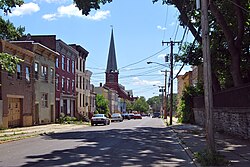South End-Groesbeckville Historic District
|
South End–Groesbeckville
Historic District |
|

View south down Clinton Street to German Evangelical Protestant Church, 2011
|
|
| Location | Albany, NY |
|---|---|
| Coordinates | 42°38′23″N 73°45′38″W / 42.63972°N 73.76056°WCoordinates: 42°38′23″N 73°45′38″W / 42.63972°N 73.76056°W |
| Area | 57 acres (23 ha) |
| Built | 1761–1930 |
| Architect | Multiple |
| Architectural style | Greek Revival, Stick/Eastlake, Italianate |
| NRHP Reference # | 84002062 |
| Added to NRHP | September 13, 1984 |
The South End–Groesbeckville Historic District is located in part of the neighborhood of that name in Albany, New York, United States. It is a 26-block area south of the Mansion and Pastures neighborhoods with a mix of residential and commercial properties. In 1984 it was recognized as a historic district and listed on the National Register of Historic Places.
For several decades after the city's founding in the late 17th century, it was an undeveloped area. In 1761 General Philip Schuyler built his house there. Today it is a National Historic Landmark, the oldest building in the district and the only contributing property in the district individually listed on the National Register.
As the city grew following the opening of the Erie Canal in the early 19th century, development did not reach the South End immediately, save for an early toll road, now South Pearl Street (part of New York State Route 32) built in the first years of the 19th century, which later became the backbone of the South End and remains important. Planned streets for the neighborhood were included in Albany's grid pattern as early as 1818. They were built in the middle of the century, and by the 1870s the district had begun to grow rapidly, fueled by German immigrants, a group still closely associated with the South End and the first of several waves of immigrants to leave their mark on it. Irish Americans would also consider it theirs even as they dispersed to other parts of the city, and one native of the district, Daniel P. O'Connell, grew up to become boss of the city's Democratic political machine well into the 20th century, using a now-demolished building in the district as his headquarters.
...
Wikipedia


